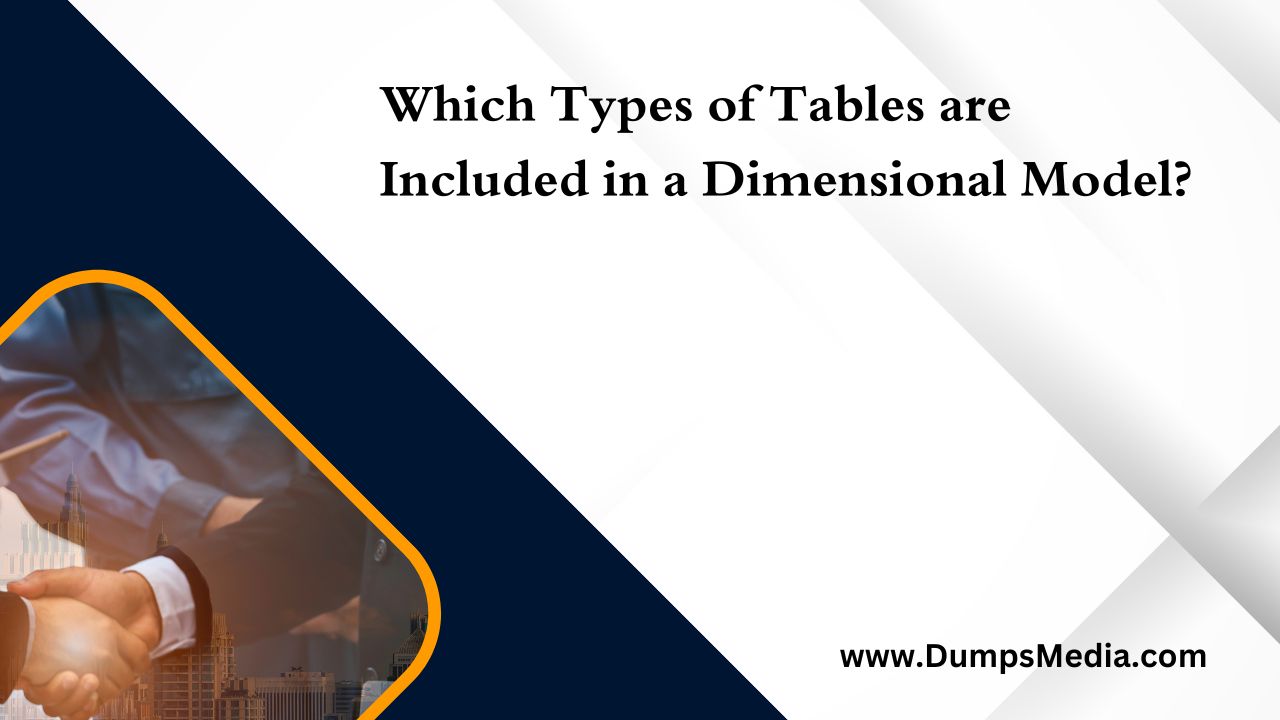Welcome to the exciting world of Which Types of Tables are Included in a Dimensional Model modeling! If you’re new to this concept, don’t worry – we’ve got you covered. In this blog post, we’ll be diving deep into the types of tables that are included in a dimensional model.
Whether you’re a data enthusiast or simply curious about how businesses organize their data for analysis, this article will provide valuable insights. So grab your favorite beverage and let’s embark on a journey through the fascinating realm of dimensional modeling!
Defining a Dimensional Model
A dimensional model is a data modeling technique used in business intelligence and analytics to organize data for easy analysis and reporting. Unlike traditional relational models, which focus on the relationships between entities, dimensional models emphasize the ability to slice and dice data along multiple dimensions.
The cornerstone of a dimensional model is the fact table, which contains quantitative measures or facts about a specific event or transaction. These facts are typically numeric values such as sales revenue, units sold, or customer satisfaction ratings. Fact tables serve as the central hub of information in a dimensional model.
In contrast to fact tables, Which Types of Tables are Included in a Dimensional Model provide descriptive attributes that help describe and categorize the facts. These attributes act as filters or axes along which users can analyze their data. For example, in an e-commerce environment, dimension tables might include product names, customer demographics, and time periods.
By separating facts from Which Types of Tables are Included in a Dimensional Model in this way, analysts gain greater flexibility when querying data for insights. They can easily aggregate or drill down into specific subsets of information by leveraging various dimensions.
Which Types of Tables are Included in a Dimensional Model follows a star schema structure where one central fact table is surrounded by multiple dimension tables radiating outwards like spokes on a wheel. This design allows for efficient query performance since it avoids complex joins often found in normalized relational models.
Understanding the fundamentals of Which Types of Tables are Included in a Dimensional Model businesses with powerful capabilities to unlock valuable insights from their data reservoirs. In our next sections we will explore some common types of dimension tables you’ll encounter within this framework!
Understanding Fact Tables
A crucial component of a Which Types of Tables are Included in a Dimensional Model. This table holds the measurable and numerical data that represents the business transactions or events being analyzed. It provides context to these events by storing various dimensions related to them.
Fact tables are typically large in size, as they contain millions or even billions of rows. Each row in the fact table corresponds to a specific event or transaction, and it contains foreign keys that link it to the dimension tables.
One important characteristic of fact tables is that they contain measures or metrics. These measures represent quantitative data such as sales revenue, quantity sold, or customer count. By aggregating and analyzing these measures across different dimensions, businesses can gain valuable insights into their operations.
Fact tables also include surrogate keys which serve as unique identifiers for each row in the table. Surrogate keys help improve performance when querying large datasets because they are usually smaller than natural keys.
Understanding fact tables is essential for building an effective dimensional model. They store measurable data linked to dimension tables and provide valuable insights through analysis of their measures across different dimensions
Exploring Which Types of Tables are Included in a Dimensional Model
Which Types of Tables are Included in a Dimensional Model play a crucial role in a dimensional model as they provide context and additional information to the data stored in fact tables. These tables contain descriptive attributes that help categorize, classify, and filter data for analysis.
One of the most common types of dimension tables is the Date/Time dimension. This table provides details about specific dates or times, enabling users to analyze data based on different time periods such as days, weeks, months, or years. It includes attributes like date, month, year, day of the week, and more.
Another important type of dimension table is the Which Types of Tables are Included in a Dimensional Model. This table contains geographical information such as country names, regions, cities, postal codes – anything that helps define a location. With this information at hand in your dimensional model, you can easily slice and dice data based on geographic criteria.
Product dimensions are also commonly used in dimensional models. These tables store detailed information about products or services offered by an organization. Attributes may include product name, category/subcategory classification (e.g., electronics/appliances), brand name(s), price range(s), and more.
These are just a few examples of dimension tables that can be included in a dimensional model to enhance analytics capabilities. By incorporating these dimensions into your model design process effectively and efficiently transform raw transactional data into actionable insights!
Common Types of Dimension Tables
One of the key components of a Which Types of Tables are Included in a Dimensional Model. These tables provide descriptive information about various aspects of your business, such as products, customers, time, and geography. Let’s take a closer look at some common types of dimension tables.
1. Date/Time Dimensions: This type of dimension table contains attributes related to dates and times. It can include columns for year, month, day, hour, minute, and second. Such dimensions are useful for analyzing data based on specific time periods or trends.
2. Geography Dimensions: A geography dimension table provides details about different locations or regions relevant to your business operations. It may contain attributes like country, state/province, city/township, postal code, latitude/longitude coordinates etc.
3. Product Dimensions: In many businesses, product-related information plays a crucial role in analysis and decision-making processes. A product dimension table includes attributes like product name/type/category/subcategory/sku along with other relevant details such as price and supplier information.
These are just a few examples; there can be DumpsMedia numerous other types of dimension tables depending on the specific needs and nature of your business.
Date/Time Dimensions
Date/Time Dimensions play a crucial role in Which Types of Tables are Included in a Dimensional Model. They are used to track and analyze data related to time, such as sales trends, customer behavior over specific periods, or website traffic patterns. These dimensions provide valuable insights into how events or actions change over time.
One common type of Date/Time Dimension is the Calendar dimension. It includes attributes like year, month, day, and weekday. This allows analysts to slice and dice data based on different date levels for more detailed analysis.
Another important aspect of Date/Time Dimensions is the concept of Time Hierarchies. A hierarchy can be defined by drilling down from higher-level attributes (e.g., year) to lower-level attributes (e.g., month and day). This enables users to analyze data at various granularities.
In addition to the Calendar dimension, other types of Date/Time Dimensions may include Fiscal Calendars (used in financial reporting), Time-of-Day dimensions (to track hourly trends), or even Seasonal dimensions (for industries influenced by seasonal variations).
Implementing Date/Time Which Types of Tables are Included in a Dimensional Model requires careful consideration of factors like time zones, daylight saving changes, and historical perspective when dealing with past data.
Geography Dimensions
Geography Which Types of Tables are Included in a Dimensional Model dimensional modeling, providing valuable context for analyzing data related to geographical locations. These dimensions help us understand the relationships between various data points and their geographic attributes.
One common type of Geography Dimension is the Location Dimension, which includes information such as country, state/province, city, zip code, latitude, and longitude. This dimension allows us to analyze data by different levels of geography – from global down to specific regions or cities.
Another important Geography Which Types of Tables are Included in a Dimensional Model. It helps us align our data with different time zones across the world and enables accurate analysis based on local time references.
In the realm of dimensional modeling, a critical aspect lies in understanding and defining the geography dimensions that are instrumental for data analysis. When it comes to determining which types of tables should be included in a dimensional model, there is a need for careful consideration and strategic decision-making.
Firstly, one must contemplate incorporating core dimension tables such as “Location” or “Address,” comprising essential attributes such as street name, postal code, city, state/province, country details alongside latitude and longitude coordinates. These foundational elements serve as building blocks for subsequent analyses involving geospatial relationships or regional comparisons.
Additionally, supplementary dimension tables like “Time Zone” may enhance analytical capabilities by providing relevant temporal aspects pertinent to specific geographic regions. Moreover, including specialized geography-related datasets can further enrich the model’s comprehensiveness; these might encompass detailed demographic information like population density or socioeconomic indicators that facilitate more insightful analysis within geographical contexts.
Product Dimensions
Product Which Types of Tables are Included in a Dimensional Model as they provide detailed information about the products being analyzed. These dimensions help to classify and organize data related to different product attributes, such as type, category, brand, size, color, and more.
One of the common types of Product Which Types of Tables are Included in a Dimensional Model is the Category Dimension. This dimension allows users to group products into categories such as electronics, clothing, furniture, or books. It enables efficient analysis by providing a hierarchical structure that helps in drill-down and roll-up operations.
Another important type is the Brand Dimension. This dimension provides details about various brands associated with the products. It includes attributes like brand name, manufacturer information, and even customer preferences for specific brands.
In addition to these dimensions, there can also be Size Dimensions that capture information regarding different sizes available for products like clothing or shoes. Color Dimensions are used when analyzing products where color plays a significant role in decision-making.
Product Dimensions enhance data analysis capabilities by providing comprehensive insights into various aspects of products. They enable users to slice and dice data based on different product characteristics and make informed decisions for business growth. By incorporating these dimensions into a dimensional model effectively will result in improved reporting and analytics capabilities for businesses operating in diverse industries.
Conclusion
Which Types of Tables are Included in a Dimensional Model is a crucial component of data warehousing and business intelligence. It provides an effective way to organize and analyze large amounts of data in a user-friendly manner. By separating the measurement data into fact tables and the descriptive attributes into dimension tables, users can easily navigate through complex datasets and gain valuable insights.
When it comes to building a dimensional model, understanding the different types of tables is essential. Fact tables capture the numerical measurements or metrics that are being analyzed, while dimension tables provide context and descriptive information about those measurements.
Some common types of dimension tables include date/time dimensions, geography dimensions, and product dimensions. These dimension tables allow for meaningful analysis by providing additional details such as time periods, geographical locations, or product hierarchies.
By incorporating these various types of tables in your Which Types of Tables are Included in a Dimensional Model, you can create a robust framework for analyzing your data effectively. Remember that the specific types of dimension tables you need will depend on your organization’s unique requirements and goals.
So whether you’re working with sales data, customer behavior patterns, or any other type of dataset that requires detailed analysis at different levels of granularity – understanding how to structure your dimensional model will greatly enhance your ability to derive actionable insights from your data.
Which Types of Tables are Included in a Dimensional Model for your organization’s business intelligence needs,
consider carefully selecting the appropriate fact and dimension table structures. This will ensure efficient querying capabilities for fast analytical processing while preserving flexibility for future growth.











“I have been studying for my data modeling certification and DumpsMedia has been a lifesaver. Their practice tests are spot on and their study materials are comprehensive and easy to understand. Thanks to DumpsMedia, I was able to pass my exam with flying colors!”
“I cannot thank DumpsMedia enough for their comprehensive study materials and practice tests. As a data analyst, I was struggling to understand dimensional modeling and its various components. But with the help of DumpsMedia’s study guide, I not only gained a better understanding of it but also aced my certification exam. Their material is well-organized, easy to understand, and has all the necessary information. Thank you so much for making my learning experience smooth and successful!”
“I have been struggling to understand dimensional modeling for my data analysis projects, but thanks to DumpsMedia, I now have a clear understanding of the different types of tables included in this model. Their study materials are well-organized and easy to comprehend, making it much easier for me to apply these concepts in my work. Thank you DumpsMedia for providing such valuable resources!”
“I cannot recommend DumpsMedia enough for their thorough and accurate study materials. As a data analyst, I have used their dimensional model tables extensively in my work and they have never let me down. The clarity and organization of the information has greatly improved my understanding of dimensional modeling. Thank you DumpsMedia for providing such a valuable resource!”
“DumpsMedia has been a lifesaver for me! As someone who works in data analysis, I have always struggled with understanding dimensional modeling and the different types of tables involved. But thanks to DumpsMedia’s clear and concise explanations, I now feel confident in my knowledge and skills. Their resources have truly helped me excel in my career.”
“I am a data analyst and have been using DumpsMedia for my certification exam preparation. I cannot thank them enough for their comprehensive study materials and practice tests. Their resources are well-structured and easy to understand, making it easier for me to grasp complex concepts. Thanks to DumpsMedia, I passed my certification exam with flying colors! Highly recommend their services to anyone looking to excel in the IT industry.”
Navigating the intricacies of dimensional modeling was made seamless with the insightful guide on “Which Types of Tables are Included in a Dimensional Model” from DumpsMedia. The clarity and depth of information provided on their website are truly commendable.
DumpsMedia is a game-changer for anyone delving into the world of dimensional modeling. Their resource on “Which Types of Tables are Included in a Dimensional Model” is an invaluable asset, offering a comprehensive understanding that’s both accessible and thorough.
Exploring dimensional modeling became a breeze thanks to DumpsMedia’s resource on “Which Types of Tables are Included in a Dimensional Model.” The content is well-structured, making complex concepts easy to grasp, and their website is now my go-to for reliable information.
DumpsMedia has crafted a gem for learners interested in dimensional modeling. The guide on “Which Types of Tables are Included in a Dimensional Model” not only simplifies the subject but also adds depth, making it a must-read on their user-friendly website.
A sincere shoutout to DumpsMedia for demystifying dimensional modeling with their exceptional resource. The content on “Which Types of Tables are Included in a Dimensional Model” is presented in a way that caters to both beginners and those seeking advanced insights.
DumpsMedia’s website is a treasure trove for those keen on understanding dimensional modeling, and their guide on “Which Types of Tables are Included in a Dimensional Model” is a masterpiece. It’s concise, yet thorough, offering a wealth of knowledge in a digestible manner.
Kudos to DumpsMedia for delivering a fantastic resource on dimensional modeling. The guide, “Which Types of Tables are Included in a Dimensional Model,” is a must-read, and their website proves to be a reliable companion for anyone diving into this subject.
DumpsMedia deserves applause for their contribution to understanding dimensional modeling. The guide on “Which Types of Tables are Included in a Dimensional Model” is an excellent reference point, and their website’s user-friendly interface enhances the learning experience.
I found DumpsMedia’s guide on “Which Types of Tables are Included in a Dimensional Model” to be incredibly helpful in navigating the complexities of dimensional modeling. Their website stands out as a reliable source for quality educational content.
DumpsMedia sets the standard with their insightful guide on “Which Types of Tables are Included in a Dimensional Model.” Navigating through the intricacies of dimensional modeling is made simpler, thanks to their user-friendly website and well-crafted content.